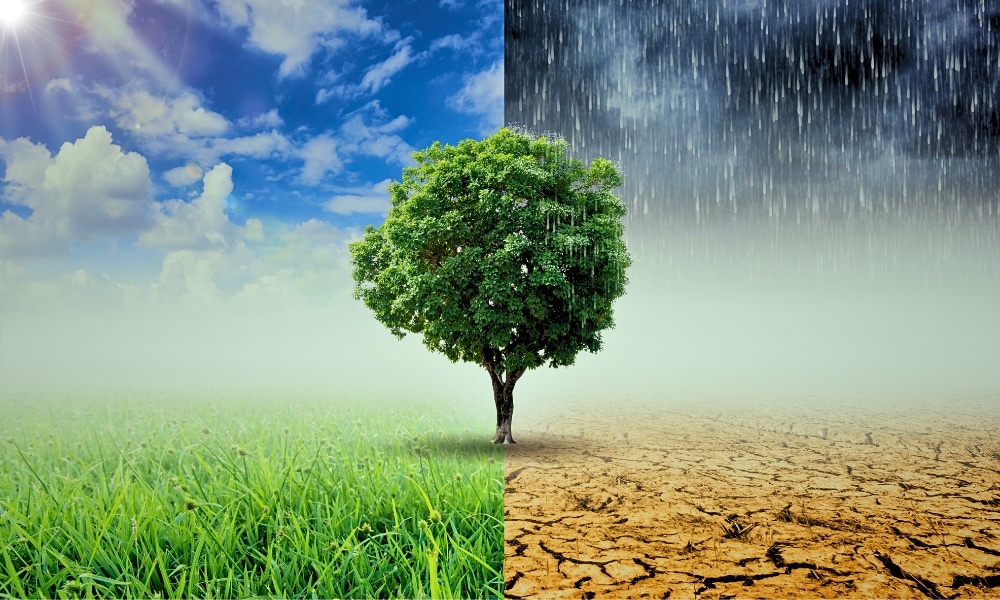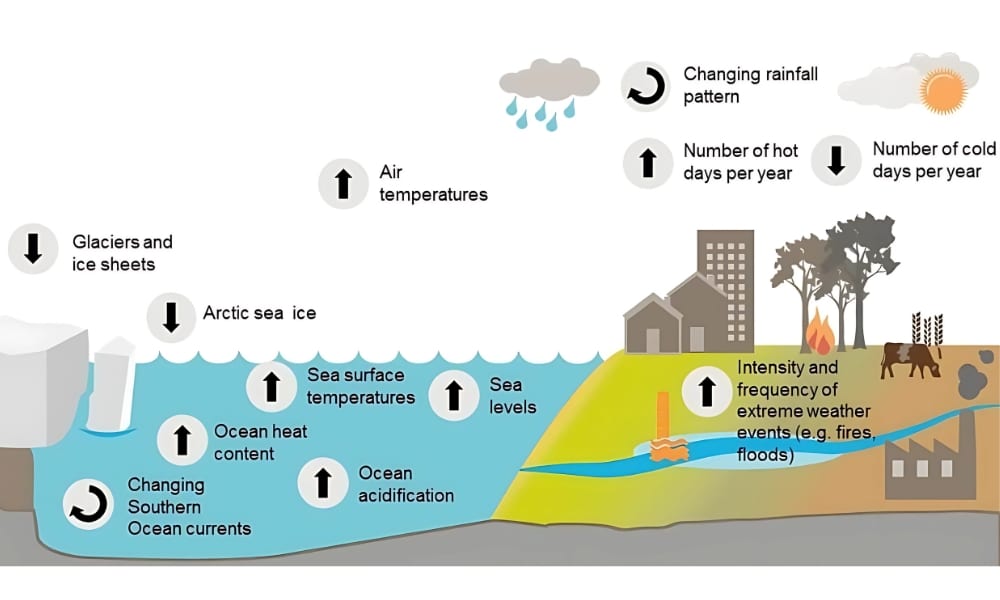Australia, a land of diverse ecosystems and vibrant communities, faces the escalating challenges of climate change. Understanding the fundamentals of this global phenomenon is crucial for effective action. This educational page aims to provide a comprehensive overview of climate change, its underlying causes, and its profound effects, explicitly impacting Australia.

On this page
What is climate change?
Climate change refers to significant, long-term alterations in global weather patterns, primarily driven by human activities that increase greenhouse gas concentrations in the atmosphere. These changes manifest as rising global temperatures, shifting precipitation patterns, and an increased frequency of extreme weather events.
- Climate change refers to long-term shifts in temperatures and weather patterns. These shifts can be natural, but since the 1800s, human activities have been the main driver, primarily due to the burning of fossil fuels (coal, oil, and gas).
- This burning of fossil fuels releases greenhouse gases into the atmosphere, which trap heat and cause the planet to warm.
- The Intergovernmental Panel on Climate Change (IPCC) reports that the global average temperature has increased by approximately 1.1°C since the pre-industrial era.
Did you know Energy Matters is Australia’s largest renewable news, blog and educational resource? Subscribe to Energy Matters’ weekly newsletter and keep updated even with incentives, rebates and recommended solar product offers.
Causes of climate change: A deeper dive
Understanding the causes of climate change is essential for mitigation.
- Greenhouse gas emissions: The primary driver is the increased concentration of greenhouse gases like carbon dioxide (CO2), methane (CH4), and nitrous oxide (N2O).
- According to the Australian Department of Climate Change, Energy, the Environment and Water, energy production, including electricity generation and transport, is a major contributor to Australia’s greenhouse gas emissions.
- Land use changes, including deforestation and agriculture, also contribute significantly.
- Fossil fuel combustion: The burning of coal, oil, and natural gas for energy, transportation, and industrial processes releases large amounts of CO2 into the atmosphere.
- Despite its efforts in renewable energy, Australia has historically relied heavily on coal-fired power plants.
- Deforestation: Forests absorb CO2, so their destruction releases stored carbon into the atmosphere.
- Agriculture: Livestock farming produces methane, and using fertilisers releases nitrous oxide.
- Industrial processes: Certain industrial activities release potent greenhouse gases like fluorinated gases.
Climate change effects in Australia: A growing concern
The impact of climate change is becoming increasingly evident across Australia.

1. Rising temperatures
Australia is experiencing more frequent and intense heat waves.
- The Bureau of Meteorology (BOM) indicates that Australia’s average temperatures have increased by approximately 1.47°C since 1910.
- This has resulted in an increased risk of bushfires and heat-related illnesses.
2. Increased bushfire risk
Higher temperatures and drier conditions contribute to more frequent and severe bushfires. Longer and more intense fire seasons have been observed, with dangerous fire weather days becoming more common. This escalation threatens ecosystems, property, and lives.
- The 2019-20 Black Summer bushfires were a stark example of the devastating impact of climate change.
3. Changes in rainfall patterns
Some regions are experiencing more intense rainfall and flooding, while others face prolonged droughts. This variability affects agriculture, water resources, and ecosystems.
4. Sea level rise
Rising sea levels threaten coastal communities and ecosystems.
- The CSIRO reports that sea levels around Australia have risen by about 21 cm since 1880.
- This is leading to coastal erosion and inundation.
5. Impacts on the Great Barrier Reef
Warmer ocean temperatures are causing coral bleaching, threatening the reef’s health. Repeated bleaching events impact the reef’s biodiversity and the tourism industry.
6. Impacts on biodiversity
Shifts in temperature and rainfall impact native flora and fauna. Numerous species are finding it difficult to adapt to the swiftly changing conditions.
7. Impacts on agriculture
Climate change is influencing crop yields and livestock production. Droughts and heat waves are impacting agricultural productivity and food security.
8. Impacts on water resources
Changes in rainfall patterns and greater evaporation affect water availability, resulting in water scarcity across many regions.
9. Extreme weather events
The increased frequency and intensity of extreme weather events, such as storms and floods, are causing significant damage to infrastructure and property.
10. Health impacts
Rising heat waves are causing heat-related illnesses and fatalities. Climate change is also influencing the spread of vector-borne diseases.
Addressing climate change in Australia
To mitigate and adapt to climate change, Australia can pursue several strategies:
- Transition to renewable energy: Investing in solar, wind, and other renewable energy sources can reduce reliance on fossil fuels and lower greenhouse gas emissions.
- Enhance energy efficiency: Implementing energy-saving technologies and practices across industries and households can significantly cut energy consumption.
- Reforestation and land management: Restoring forests and adopting sustainable land-use practices can enhance carbon sequestration and reduce emissions from deforestation.
- Climate-resilient infrastructure: Developing infrastructure that can withstand extreme weather will protect communities and reduce economic losses.
- Policy and legislation: Enacting and enforcing policies that limit emissions, promote sustainable practices, and support climate adaptation efforts are crucial for long-term change.
- Public awareness and education: Educating citizens about climate change and encouraging sustainable behaviors can drive collective action and support for climate initiatives.
Sources: Australian Government Department of Climate Change, Energy, the Environment and Water – Understanding climate change | Australian Museum – Impacts of Climate Change | CSIRO – Climate Change
These informative videos are a great way to understand climate change visually.
Take the next step towards a sustainable future with Energy Matters
Australia is facing significant challenges from climate change. Understanding its causes and effects is vital for developing effective solutions. Australia can mitigate its emissions by transitioning to renewable energy, improving energy efficiency, and implementing sustainable land management practices. Adaptation strategies are also crucial for managing the unavoidable impacts of a changing climate. We all must take action to protect our planet for future generations.
Energy Matters urges you to explore sustainable solutions and embrace a cleaner future. Let’s power change together!
Energy Matters has been recognised for our continued excellence in the Australian solar industry. We provide our customers with high-quality resources, insight, and access to reputable solar quotes.
Our team of solar experts can help you get up to 3 FREE solar quotes from pre-qualified and vetted solar firms in your area.















































